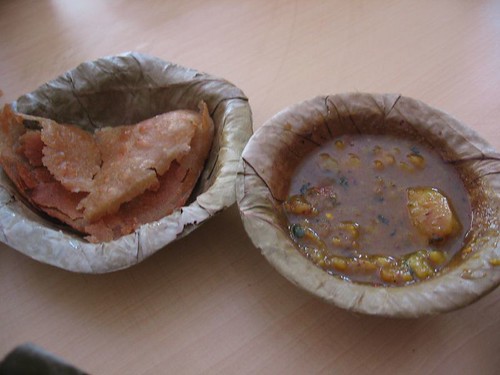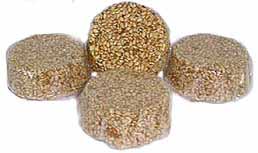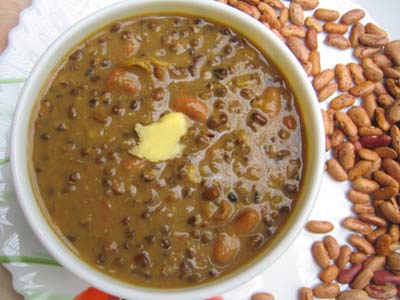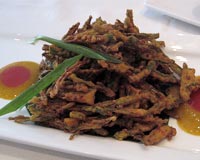 Dried legumes and their edible seeds, known as pulses, are classified into three groups - lentils, beans and peas. Legumes and Pulses are a natural source of protein, high in fibre and low in fat. They have a wide range of flavours and textures and form a large part of the Indian daily diet.They are eaten either whole (with the skin still intact) or split in half (with or without their skins). The term "dal"or "daal" refers to a bean or lentil which has had the outer husk removed and the remaining lentil is then split. This ensures a quicker cooking time and a softer, creamier texture when cooked.The Importance of Lentsils and Pulses In Indian Cooking:
Dried legumes and their edible seeds, known as pulses, are classified into three groups - lentils, beans and peas. Legumes and Pulses are a natural source of protein, high in fibre and low in fat. They have a wide range of flavours and textures and form a large part of the Indian daily diet.They are eaten either whole (with the skin still intact) or split in half (with or without their skins). The term "dal"or "daal" refers to a bean or lentil which has had the outer husk removed and the remaining lentil is then split. This ensures a quicker cooking time and a softer, creamier texture when cooked.The Importance of Lentsils and Pulses In Indian Cooking:Dal or lentils is the staple food in every Indian home. Both the rich and the common person who lives on the street enjoy it. It is what chicken soup is to the west – it is India’s comfort food.
A large percentage of Indians are vegetarian and lentils have long been part of the indigenous diet as a common source of protein. Usually, lentils are boiled to a stew-like consistency with vegetables and then seasoned with a mixture of spices to make many side dishes such as sambar, rasam and dal, which are usually served over rice and roti.
Dals or lentils, peas and beans are cooked practically daily in almost every Indian home, vegetarian or not. Each region has its own favorites and cooking methods. Some are cooked with garlic and ginger, in addition to the staple spices of turmeric, cumin and coriander. Dals can range from spicy-sweet to scorching hot, soup like or like creamed thick soup or dry like a pilaf.
Types Of Dals: Chana Dal:
Chana Dal:The words "chana dal" mean "split chickpeas." (Chana gram is a whole chickpea). Chana dal are baby chickpeas that have been split and polished. They look and taste like small kernels of sweet corn and work well in soups, salads, and rice dishes.
The most popular legume in India. Chana dal is a very versatile dried split yellow lentil with a slightly sweet taste, nutty flavor. It is used in variety of vegetable dishes. It can be cooked until soft for the dish called simply dal (yellow dal), or as in southern India it can be used as a spice.
 Tur Dal/ Tuvar Dal/ Toor Dal:
Tur Dal/ Tuvar Dal/ Toor Dal:Toor Dal is a glassy dark yellow split pea (pigeon pea), similar to chana dal. Toovar da exhibits a thick gelatinous/meaty consistency. They take a little longer to cook than moong or masoor dal/dahl. These yellow split peas can be made into dal which is served with side dish of vegetables, rice or flat breads.The South Indian delicacy, sambhar which is an accompaniment for dosa, idli or even rice is cooked with toordal.
 Urad Dal (Whole And Split):
Urad Dal (Whole And Split):Also called Black Beluga Lentils. Whole Urad dal/dahl is used more like a chili or stew than a soup or dal/dahl. These lentil-like beans have black skins covering creamy white interiors. Whole urad dal/dahl derive their strong, rich, earthy flavor from the black skins and have an uncanny ability to absorb flavors. Split and without the skin Urad dal is a white lentil used along with rice to make dosas, the crisp pancakes of southern India and other Rice preparations. In South India, Urad dal is used as a seasoning with mustard seeds for curries.
 Mung Dal/ Moong Dal:
Mung Dal/ Moong Dal:Whole moong is actually a bean or pulse and is known as 'sabat moong' . They are small green beans fairly used in India, China, Thailand and Japan. Sprouted they are used in salads or stir fries with lemon juice or vinaigrette.
In India Moong dal is used, which is split moong beans with the skin left (green skin yellow lentil) on or without the skin(yellow lentil). It is used to make delicious dals and curries. Moong lentils in particular is very easy to digest and take on seasonings and spices very well.
 Masoor Dal:
Masoor Dal:While whole, this bean is greenish-brown, even though they can be prepared whole (masoor beans) Indian recipes often call for the skinned and split masoor, which is called masoor dal. Skinned split Masoor beans are actually called red lentils (orange in color).
They have a dark, earthy flavor and a creamy texture. These lentils pair well with tomatoes and kheema/mince meats, sausages, and may be served on their own as a side dish, or incorporated into soups, stews, salads and Indian dal.
Types Of Pulses: Rajma (Red Kidney Beans):
Rajma (Red Kidney Beans):
The kidney bean with its dark red skin is named for its visual resemblance to a kidney. The kidney bean is also known as the red bean, although this usage can cause confusion with other red beans. Red kidney beans (Rājmā in Hindi and Punjabi) are an integral part of the cuisine in northern region of India.
 Lobiya/ Chawli/ Black Eye Peas:
Lobiya/ Chawli/ Black Eye Peas:These are a subspecies of the cowpea, grown for its medium-sized edible bean, which mutates easily giving rise to a number of varieties, the common commercial one called the California Blackeye being pale-colored with a prominent black spot. Quite popular in the west especially South America...it is often used in Indian Cooking as well.
 Chick Pea/ Bengal Gram/ Chana:
Chick Pea/ Bengal Gram/ Chana:Also known as Chole, Garbanzo Beans and Egyptian Peas, White Chickpeas or Kabuli Chana has a lovely nutty flavor. Chickpeas in India come in different colors and are known by different names. There are two main kinds of chickpea.
- Desi (Indian), which has small, darker seeds and a rough coat, cultivated mostly in the Indian subcontinent, Ethiopia, Mexico and Iran.
- Kabuli, which has lighter coloured, larger seeds and a smoother coat, mainly grown in Southern Europe, Northern Africa, Afghanistan and Chile, also introduced during the 18th century to the Indian subcontinent).
The Desi (meaning country or local in Hindi) is also known as Bengal gram or kala chana. Kabuli (meaning from Kabul in Hindi, since they were thought to have come from Afghanistan when first seen in India) is the kind widely grown throughout the Mediterranean.
Apart from these Moong Beans, Masoor beans and Pigeon Peas (Tur dal in it's whole form)...all mention in the dals (lentils list) are commonly used in Indian Cooking. These are just the most common and popular lentils and Pulses you'll find in almost every Indian kitchen. But to give you an idea of how popular and Pulses and lentils are in Indian Cuisine- Over 50 different varieties of pulses are known in India.
 Bajra Khichdi id quiet popular in the regions of Rajasthan. Bajra is widely cultivated in India since thousands of years. Bajra is the basic staple food to many poor people in India and to those especially living in the remote rural areas. Bajra contains high source of Vitamin B and Iron and thus provides the energy needed to people consuming it in meals. Rajasthan being a drought hit and dry region, people often prepare Khichdi and especially Bajra khichdi is their top priority due to its nutritious value. To supplement this nutrious value to some extra level , it is prepared using ghee which provides fats. This cuisine is a instant and fast to prepare as it requires just 10-12 minutes to get ready.
Bajra Khichdi id quiet popular in the regions of Rajasthan. Bajra is widely cultivated in India since thousands of years. Bajra is the basic staple food to many poor people in India and to those especially living in the remote rural areas. Bajra contains high source of Vitamin B and Iron and thus provides the energy needed to people consuming it in meals. Rajasthan being a drought hit and dry region, people often prepare Khichdi and especially Bajra khichdi is their top priority due to its nutritious value. To supplement this nutrious value to some extra level , it is prepared using ghee which provides fats. This cuisine is a instant and fast to prepare as it requires just 10-12 minutes to get ready.

















































